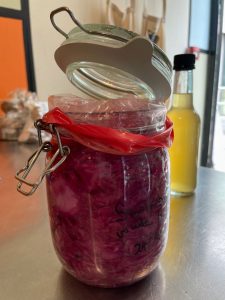For our final Food for Mood recipe, Caroline from Every Good Thing showed us how to make Sauerkraut. This is a German dish that literally translates as “sour cabbage” but don’t let that put you off. Sauerkraut is made by the process of lacto-fermentation, where we’ll be using helpful bacteria present on the veggies and a little salt to make a delicious live pickle that will be packed with nutrients, lactic acid bacteria and fibre – all fantastic for your gut health. Unless you’ve been living in a cave for the last few years, you’ll know something about how important looking after your gut health is! This is a very simple recipe.
Equipment

- A clean jar of at least 500 mls capacity, either with or without a lid *see below, can also be a clip top jar, or special fermentation jar.
- Weighing Scales
- A sharp knife
- A chopping board
- A colander
- A large bowl
- *A plastic bag and a rubber band if you don’t have a lid
- Something to submerge the cabbage with – a plastic food safe disc from a food container could be useful, or a small jar, or a cabbage leaf even, but don’t worry we can be creative with this on the night.
Ingredients
Use same weight of vegetables as your jar capacity – so approx. 500g cabbage for a 500 ml jar, or 1 kilo for a litre jar.
- Salt – approx. 10g for a 500g jar, 20g for a litre jar.
- Any combination of: White cabbage, pointed cabbage, red cabbage, carrots, fennel, kohlrabi, a bit of apple, a bit of beetroot
- Optional: Any of.. Caraway seeds, fennel seeds, cumin, coriander, pepper etc..
Method
- Make sure you, the equipment and your working area are clean and free from possible raw meat / animal contamination.
- Finely slice cabbage, and place in colander.
- Rinse well and drain.
- Place bowl on weighing scales and set to zero.
- Add cabbage and record weight.
- Add 2% w/v salt [(weight (g) x2/100) for 800g cabbage: 800 x2/100=16 ]
- Massage with your hands until a pool of brine is created. The cabbage will change translucency (if you want to keep the end as a weight – don’t forget to salt it too).
- If you are adding caraway or other seeds, set the brine to one side in a jug, and then mix the seeds with the cabbage, otherwise they’ll mostly end up floating about in the brine and mightn’t make it to the jar. The brine can then be used to top up the jars from the jug if needed.
- Squeeze cabbage into vessel of choice, using a jam funnel, packing well ensuring no air gaps to shoulder height of the jar ( you need to leave room for expansion).
- Weigh down with method of choice, large leaf, bag of brine, small weight.
- Ensure that brine covers by at least one cm.
- Place your ferment out of direct sunlight at room temperature ( 18-22 oC ), sitting on a plate or tray in case the brine spills over.
- Ferment for at 10 days at room temperature.
- Leave for longer at room temperature for a softer texture/more farmyardy taste.
- When done, refrigerate, dispensed into clean jars if you want to re-use your fermenting vessel, or in the original.
The Do’s and Don’ts of fermenting
Remember the mantra: Chop Wash Weigh Salt!
- Don’t ferment vegetables without salt.
- Don’t ferment fruit and vegetables that are old fridge fodder. It could well be covered with various moulds/ stray bacteria from your fridge that will mean that your ferment could be more at risk of growing something it shouldn’t. Use fresh vegetables that are likely to be covered with beneficial bacteria, and wash them first at any rate.
- Don’t use damaged and/or bruised produce, including windfall fruit (jam or compote for these). Pathogenic bacteria can find their way inside the fruit via fruit flies, birds and maggots and other wildlife including strains of coli. Although both pH and competition with other bacteria can help destroy these, it’s best not to take any risks.
- Don’t cover your ferments with a layer of oil (any oil) to make an anaerobic environment. The pH of oil is not low enough to prevent the growth of pathogens including Clostridium botulinum that could become suspended in the oil on particles of food. Instead use a weight to keep your vegetables submerged under the water, and an airlock system.
- Do not use tightly sealed ( by which I mean regular) jars without gaskets, or mason jars or jars with very tight metal lids for your fermentations without venting. They could explode, due to the gases produced by the microbes while they consume the sugar. They probably won’t but better safe than sorry. Kilner jars with gaskets should allow just enough expansion to prevent a catastrophe.
Do not open your ferments to check them within 72 hours unless absolutely necessary. The pH will not be low enough to prevent possible growth of airborne contaminants.

